
Many variables can be manipulated in a muscle-building program. From exercise selection, rep ranges, the number of sets you perform, etc.
However, one of the least thought about variables is probably repetition tempo.
Table of Contents
Repetition tempo refers to the duration you perform the various muscle actions in an exercise.

For instance, you could perform an exercise with a 1 second concentric (upwards phase), 0-second isometric, and a 3-second eccentric phase (lowering phase).
Interestingly, I recently came across some research exploring if repetition tempo could impact regional muscle growth. Put differently, could different repetition tempos produce different growth on parts of a muscle?
Logically, this could make sense. It’s possible that performing an exercise with a faster or slower tempo could activate different regions of a muscle more so than others, resulting in different regional hypertrophy.
Research on Rep Tempo and Regional Growth
Strength/Hypertrophy Training vs Power Training
Earp et al. compared heavy parallel back squat training (using a 75-90% one-rep max load throughout the study) to jump parallel back squat training (using a 30% one-rep max load) for regional growth of the quadriceps muscles.
Note, the jump parallel back squat training was performed very far from muscular failure, meaning they were just explosive jumping repetitions, whereas the repetitions for the heavy parallel back squat training group would have been substantially slower as they were training closer to muscular failure.
Heavy parallel back squat training produced greater proximal (upper region) growth of the vastus lateralis and vastus intermedius compared to jump parallel back squat training (using a 30% one-rep max load).
However, jump parallel back squat training resulted in greater distal (lower region) growth of the vastus lateralis and vastus intermedius.

Given range of motion was controlled between the groups (they both squatted to parallel), repetition speed was probably the reason for these differences in regional hypertrophy.

Now, this study did compare strength/hypertrophy style training (the heavy parallel back squat) to power style training (the jump parallel back squat).
What about the use of different repetition tempos in typical strength/hypertrophy training programs?
Rep Tempo and Regional Growth in Strength/Hypertrophy Training
Protocol:
Diniz et al. split 44 untrained women into one of four groups:
1) 5-second concentric/1-second eccentric group
2) 1-second concentric/5-second eccentric group
3) 3-second concentric/3-second eccentric group
4) control group
The control group, of course, did not train and experienced no gains, so we won’t mention them any further.
The three training groups performed the knee extension for sets of 6 reps with a 50% one-rep max load, three times per week for 10 weeks.
Weeks 1 and 2 had subjects perform 3 sets per session, weeks 3 and 4 had the subjects perform 4 sets per session, and weeks 5 and 6 had the subjects perform 5 sets per session.
Subjects rested 180 seconds between sets.
The 5-second concentric/1-second eccentric group performed the knee extension with a 5 second concentric and 1-second eccentric duration.
The 1-second concentric/5-second eccentric group performed the knee extension with a 1 second concentric and 5-second eccentric duration.
The 3-second concentric/3-second eccentric group performed the knee extension with a 3 second concentric and 3-second eccentric duration.
For all three groups, there was no pausing between the eccentric and concentric phases.
Measurements:
The cross-sectional area of the rectus femoris, vastus medialis, vastus lateralis, and vastus intermedius was measured at 30%, 50%, and 70% of the thigh length.
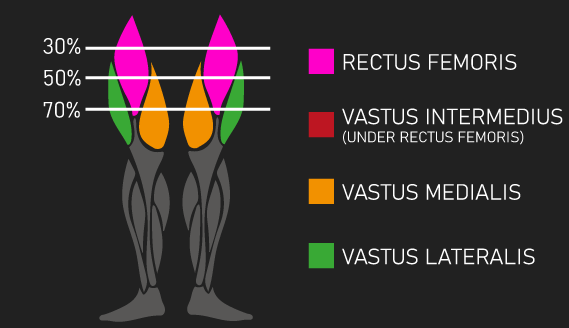
Results:
At 50% of thigh length for the rectus femoris, increases were statistically greater for the 5-second concentric/1-second eccentric group and 1-second concentric,/5-second eccentric group versus the 3-second concentric/3-second eccentric group.
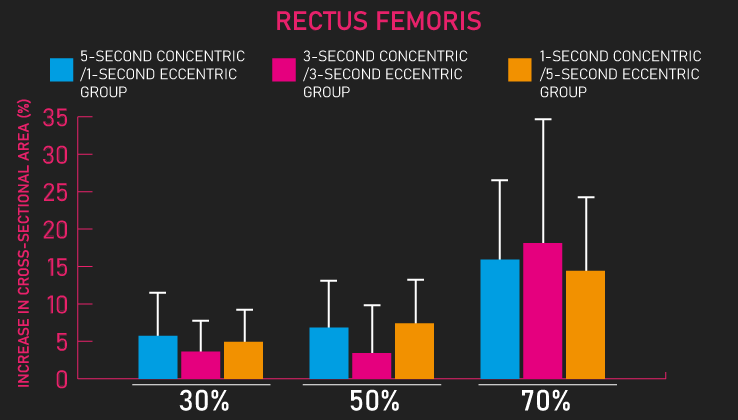


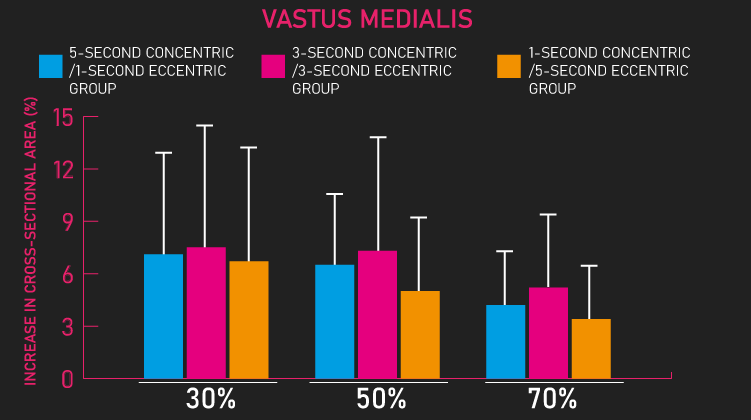
There were no other statistically significant differences.
However, looking at the overall data, there potentially could be some other practically meaningful differences.
At 70% of the thigh length for the rectus femoris, increases seem to favor the 3-second concentric/3-second eccentric group versus the other two groups.
At 30% of the thigh length for the vastus lateralis, increases seem to favor the 5-second concentric/1-second eccentric group versus the other two groups.
At 30% of the thigh length for the vastus intermedius, increases seem to favor the 1-second concentric/5-second eccentric group versus the other two groups.
At 50% of the thigh length for the vastus medialis, increases seem to favor the 3-second concentric/3-second eccentric group versus the 1-second concentric/5-second eccentric group.
Finally, at 70% of the thigh length for the vastus medialis, increases also seem to favor the 3-second concentric/3-second eccentric group versus the 1-second concentric/5-second eccentric group.
However, it’s important to note that as these differences were not statistically significant, we should be cautious here. The observed percentage differences may be just sampling error.
Nonetheless, given there was one statistically significant difference between groups (at 50% of the thigh bone length for the rectus femoris), this study does suggest different repetition tempos can produce different regional hypertrophy.
Before moving on, if you’re curious about creating an effective training program for muscle hypertrophy, our high quality partner Alpha Progression can help. It can generate a highly effective program for you, track your workouts live with in-built progression recommendations, provide graphs displaying your long term progress, and it has a massive exercise database with more than 550 exercises.
Click HERE (the link opens in a new tab) to get a free 2 week trial of the apps features. If you like it and go beyond, the link also gives you 20% off a subscription!
We never promote trash at the House of Hypertrophy, so rest assured the app is high quality. The reviews speak to this, 4.8 starts (based on more than 7,000 reviews) on Google play, and 4.9 stars in Apple’s store (based on nearly 400 ratings).
Limitations:
One noteworthy limitation of this Diniz et al. study was all three groups trained the knee extension with sets of 6 reps using a 50% one-rep max load.
Due to the differences in repetition tempo between groups, they would not have been training in equal proximity to muscular failure.
Remember, during typical exercises such as the knee extension, you are limited by your concentric strength. Prolonging this muscle action would make the exercise more difficult.
Therefore, the 5-second concentric/1-second eccentric group would have probably been training the closest to failure, followed by the 3-second concentric/3-second eccentric group, and then the 1-second concentric/5-second eccentric group.
This could have confounded the results. Perhaps some of the potential differences between groups were actually a result of different regions being more activated due to differences in fatigue.
However, remember, at 50% of the thigh bone length for the rectus femoris, increases were statistically greater for the 5-second concentric/1-second eccentric group and 1-second concentric/5-second eccentric group versus the 3-second concentric/3-second eccentric group.
The 5-second concentric/1-second eccentric group and 1-second concentric/5-second eccentric group would have been experiencing different levels of fatigue (the 5-second concentric/1-second eccentric group would have been nearer to failure). Yet, they experienced similar hypertrophy at this region, and both greater than the 3-second concentric/3-second eccentric group.
Indicating fatigue was probably not a factor here, rather it seems repetition tempo was the differentiating factor.
Let us now move on to the next study by Pearson et al.
Protocol:
13 well-trained men (at least 3 years of training experience and could squat an average 2x bodyweight) had one leg assigned to a fast eccentric condition and their other leg assigned to a slow eccentric condition.
They trained each leg on the unilateral leg extension twice per week for 8 weeks.
The leg assigned to the fast eccentric condition performed the exercise with a 1-second concentric and a 1-second eccentric duration.
The leg assigned to the slow eccentric condition also performed the exercise with a 1-second concentric, but they used a 3-second eccentric duration.
For both groups, there was no pausing between the eccentric and concentric phases.
From weeks 1-4, 3 sets with an 8-10 rep-max load was used for each leg.
From weeks 5-8, 4 sets with an 8-10 rep-max load was used for each leg.
As a note, they alternated which leg was trained first each session. 2 minutes of rest was given between sets and 3 minutes between legs.
Measurements:
The thickness of the anterior thigh (which included the rectus femoris and vastus medialis muscles) was measured for both legs at 40% and 60% of the thigh length.

Results:
Increases at 40% of the anterior thigh were similar between both the fast eccentric condition and slow eccentric condition.
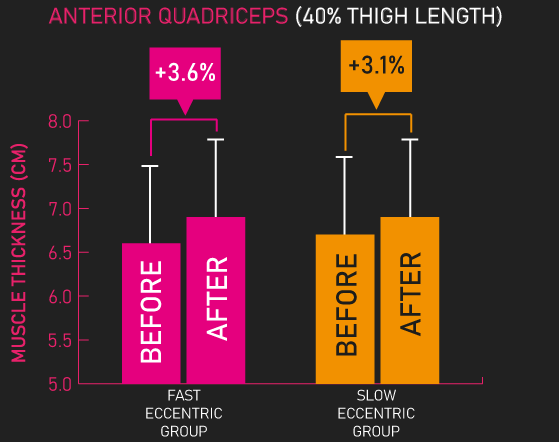
However, increases at 60% of the anterior thigh were statistically greater for the fast eccentric condition.
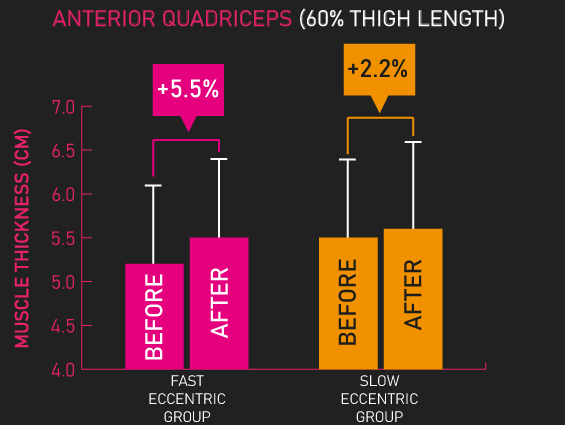
Therefore, this study suggests a 1-second eccentric duration on knee extension preferentially stimulates the vastus mediailis and rectus femoris at 60% of the thigh bone length, supporting the idea different repetition tempos may induce different regional growth.
Conclusion
From the Earp et al. study, Diniz et al. study, and Pearson et al. study, we have some evidence that different repetition tempos can influence regional muscle growth.
That said, only two of them evaluated repetition tempo during standard strength/hypertrophy training styles, so it isn’t overwhelming evidence.
However, if you were to use a variety of repetition tempos in your training routine, at the very least, muscle growth should not be harmed.
A meta-analysis by Schoenfeld et al. found that so long as reps were performed to or close to muscular failure (probably at least 2-3 reps away from failure) repetition durations ranging from 0.5 seconds to 8 seconds produces similar whole muscle growth.
And at best, as we’ve just seen, it’s quite possible different repetition tempos induces different regional growth, resulting in more uniform muscle hypertrophy.
Personally, I think this is quite an interesting area. I hope more research eventually comes out here. If it does happen, I definitely plan to update this article.
Remember to feel free to check out the Alpha Progression App if you’re interested. Also feel free to check out our free bench press e-book below.

